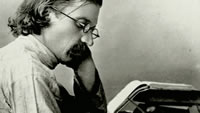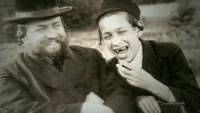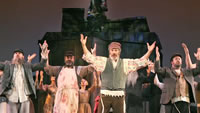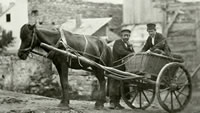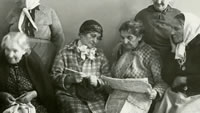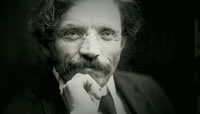Film: Sholem Aleichem: Laughing in the Darkness
Cast includes: Rachel Dratch, Hillel Halkin, Jason Kravits, Dan Miron, Peter Riegert, Alan Rosenberg
Director: Joseph Dorman (Going Upriver: The Long War of John Kerry)
Genre: Documentary (2011)
In brief: “If you could spare a moment, I’ll tell you a story.” That’s the way many of Sholem Aleichem’s stories begin. “Tevya the Dairyman” was Sholem Aleichem’s most famous character because he inspired the much-loved Fiddler on the Roof. But Tevya is only a small part of the Sholem Aleichem legacy, which includes the very concept of Yiddish literature… which even hardly even existed before Sholem Aleichem. To appreciate his legacy, we need to know something about the man and his world. He was born Sholem Rabinovich in 1859 in a shtetl (small village) near Kiev. Although everyone in the shtetl was poor, the Rabinovichs were slightly less impoverished than many. Sholem had the opportunity to study the Torah and as a young man was fluent in Hebrew, Russian and Yiddish, the language of the street.
When Sholem wanted to become a writer, his father was pleased… naturally assuming he’d be writing scholarly works in Hebrew. But Sholem wanted to write in Yiddish… a language that had almost no literary tradition. Despite his fluency in other languages, it was only in Yiddish that Sholem could express himself from the heart. His own life was not dissimilar to those he wrote about. When his mother died, his father remarried. Not wanting his new wife to know that he had twelve children, he parceled them out to other homes… eventually bringing them back one at a time. It was the shrewish stepmother who inspired one of Sholem’s earliest works, a glossary of his stepmother’s curses. Sholem’s own life was to alternate between relative prosperity and total poverty… relative artistic success and spectacular overreaching. But his stories became a staple of Yiddish culture. On Friday nights, it became a Jewish family ritual to sit around the radio and listen to them. Nearly 100 years after his death, his writings are still an important influence on modern storytelling and humor.
If, like me, you’ve grown up hearing about the stories of Sholem Aleichem but have been unable to experience them in Yiddish, this film is a wonderful introduction. Sadly Yiddish is a dying language. And that topic is also developed in this film. Once the common language of Jews all over the world, it’s now being kept alive by enthusiasts who love it. And the literary legacy of Sholem Aleichem… which goes far beyond his own works… is helping keep Yiddish alive. The film is both informative and entertaining. Amazingly, there are quite a few photographs of Sholem Aleichem… he was a bit of a dandy… and the filmmakers use them, along with many others to give the film visual appeal. This is not only a story of Sholem Aleichem, it’s a story of a people, a place, a changing world and a language.

4 popped kernels
A wonderful introduction to an amazing storyteller and his rich language
Popcorn Profile
Primary Audience: Grown-ups
Gender Appeal: Any audience
Distribution: Art house
Mood: Upbeat
Tempo: Cruises comfortably
Visual Style: Unvarnished realism
Character Development: Not that kind of film
Language: True to life
Social Significance: Informative
